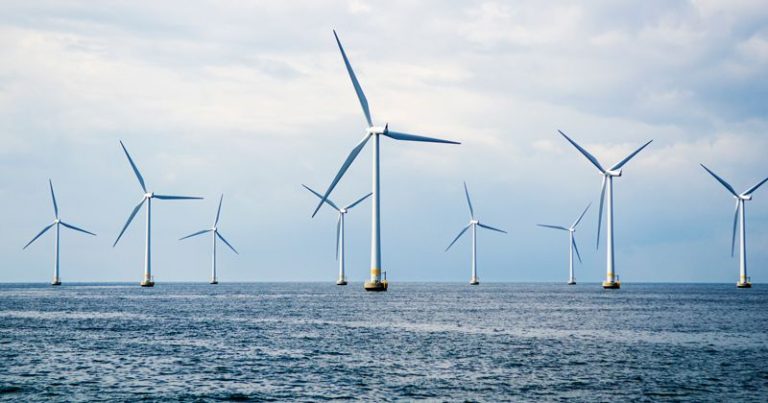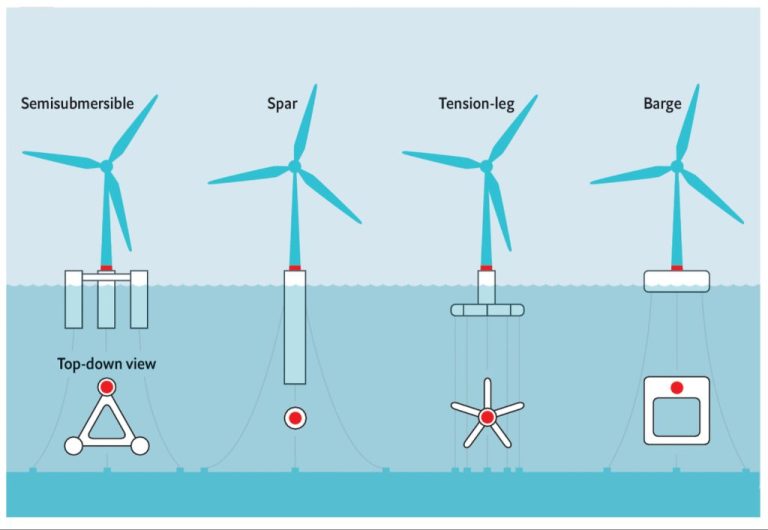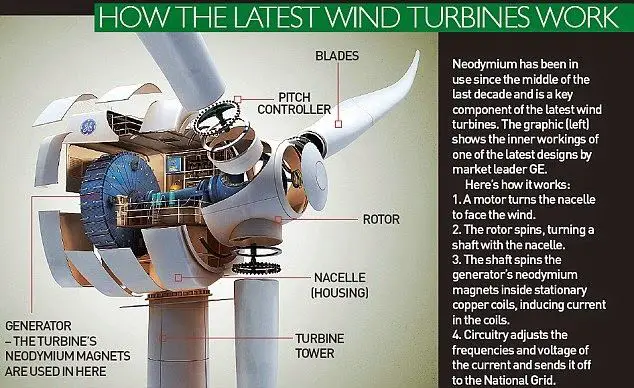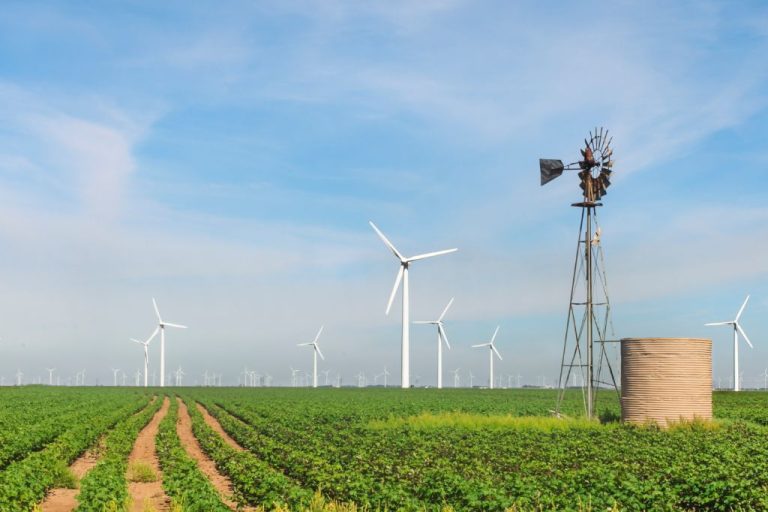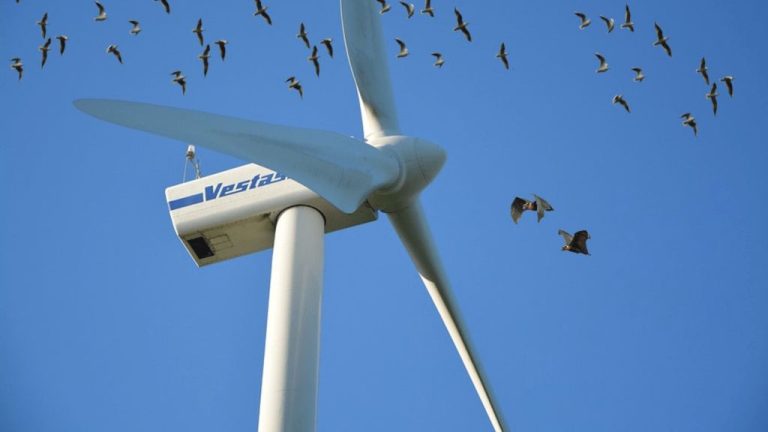How Does Wind Energy Form On Earth?
Wind energy refers to the process of harnessing the kinetic energy of wind and converting it into electrical energy through the use of wind turbines. It is considered a renewable energy source because wind will continue blowing as long as the sun shines and the Earth’s atmosphere circulates air. Wind energy is one of the fastest growing and most promising renewable energy sources in the world today.
Wind power is appealing for several reasons. First, it is plentiful – wind is present in some form across almost all parts of the globe. Second, wind energy does not produce greenhouse gas emissions that contribute to climate change like fossil fuel power plants do. Third, the costs of wind power generation have dropped dramatically in recent decades making it economical and competitive with conventional power sources. Finally, wind turbines can be installed nearly anywhere there is sufficient wind, unlike more geographically-constrained sources like hydroelectric power. For these reasons, wind energy is poised to play a major role in building a sustainable energy future.
What Causes Wind
Wind is caused by the uneven heating of the Earth’s surface by the Sun. As the Sun’s rays strike the Earth, landmasses, water bodies, and other surfaces absorb the sunlight at different rates. For example, land heats up more quickly than water. These temperature differences cause some areas of the atmosphere to become warmer than others. Warmer air is less dense and rises, while cooler air is denser and sinks. This difference in density leads to differences in atmospheric pressure.
Wind flows from high pressure areas to low pressure areas, attempting to equalize the pressure. This airflow—or movement of wind—occurs at all levels of the atmosphere. It is affected by Earth’s rotation, as well. The rotation of the Earth deflects winds to the right in the Northern Hemisphere (as the friction between the wind and the Earth’s surface causes an apparent force from the left). This is known as the Coriolis effect. So the fundamental causes of wind are the uneven heating of the Earth’s surface, differences in atmospheric pressure, and the effects of Earth’s rotation.
Global Wind Patterns
Some parts of the Earth are windier than others. On a global scale, trade winds, westerlies, and polar easterlies shape predictable wind patterns due to the Earth’s rotation and the way it heats up. Here is an overview of global wind circulation:
Trade winds – These winds blow from northeast in the Northern hemisphere and southeast in the Southern hemisphere towards the equator. They result from the pressure difference between the warm air rising over the equator and the cooler air sinking over the subtropics around 30 degrees latitude.
Doldrums – The low pressure belt around the equator with little prevailing wind is known as the doldrums or equatorial low. The heated air rising over the equator subsides here after moving poleward.
Westerlies – These prevail in the mid-latitudes around 30-60 degrees and blow from the west toward the east. As air moves poleward from the subtropical highs, the Coriolis force deflects it eastward resulting in the westerlies.
Polar easterlies – These winds blow from the east toward the west at very high latitudes near the poles. As air flows from the poles it is deflected westward by the Coriolis force creating polar easterlies.
Local Wind Patterns
In addition to the global wind patterns created by the rotation of the Earth and the heating of the atmosphere, there are several local factors that influence wind patterns. Three important local wind patterns are sea breezes, land breezes, and mountain waves.
Sea Breezes
During the day, the land heats up faster than the water. The warm air over the land expands and rises, and the heavier, cooler air from over the sea rushes in to take its place, creating a breeze blowing from the sea to the land called a sea breeze.
Land Breezes
At night, the opposite effect occurs – the land cools down faster than the water. The cool air over the land is denser than the relatively warmer air over the water, so it sinks and spreads out over the sea. This causes the wind to blow from the land out to sea, called a land breeze.
Mountain Waves
As wind approaches a mountain range, the wind is forced upwards by the terrain. This causes oscillating waves in the air flow downstream, known as mountain waves or lee waves. These waves can greatly impact local wind speeds and turbulence.
Wind Speed
Wind speed is determined primarily by temperature differences
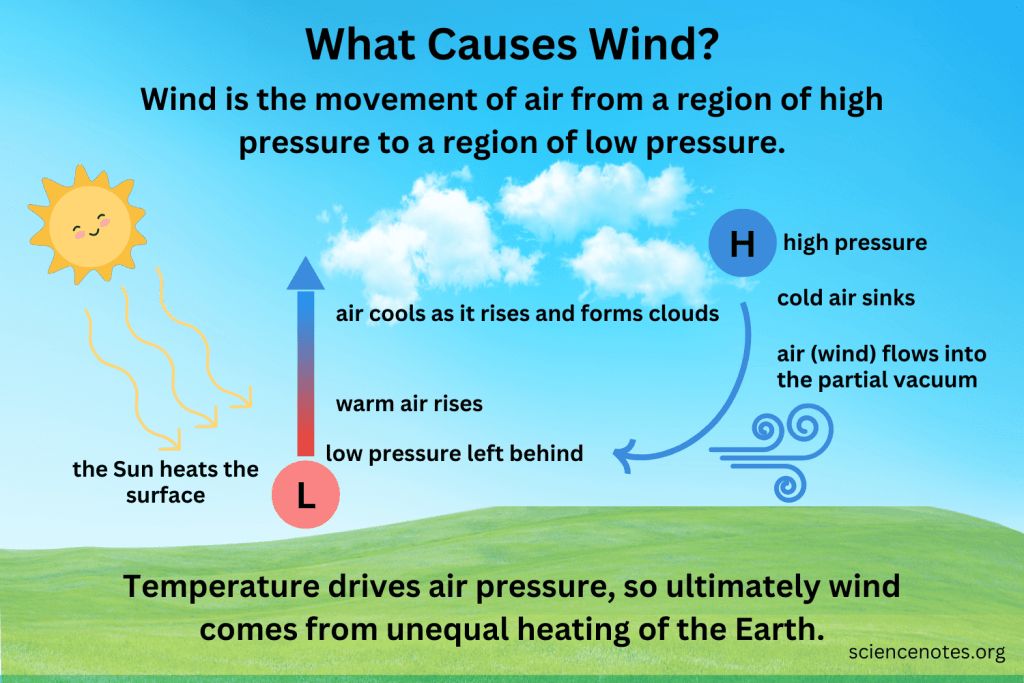
in the atmosphere. Specifically, wind is created by the temperature
contrast between two adjacent air masses. When a mass of warm air
is next to a mass of cold air, the warm air will rise and the cold air
will sink. This movement causes wind as air rushes to fill in the empty spaces.
Wind speeds are higher when the temperature contrast between air masses is greater.
In addition to temperature differences, wind speed is affected by obstructions
on the Earth’s surface like mountains, buildings, and trees. As wind encounters
these obstructions, the wind speed will slow down due to friction and turbulence.
Areas with few surface obstructions, such as plains or oceans, generally experience
faster wind speeds than areas with many obstructions. The height above the
Earth’s surface also impacts wind speed, with higher altitudes seeing faster winds.
Wind Power
The amount of power generated from wind turbines increases dramatically based on wind speed. In fact, wind power generation is proportional to wind speed cubed. That means a small increase in wind speed results in a large increase in power output. For example, if wind speed doubles, the power generated increases by a factor of eight.
Wind turbines harvest kinetic energy from the wind and convert it into electricity. Modern wind turbines are designed with vertical blades that spin a generator to produce power. The turbine blades capture the wind energy and drive the rotor to turn. This rotational energy gets converted by the generator into electrical energy that can be used to power homes, businesses, and the grid.
Wind Energy Generation
Wind turbines convert wind’s kinetic energy into electricity. As wind blows across the blades of the turbine, the blades begin to rotate. This rotation turns a shaft inside the turbine, which connects to a generator to produce electricity. The amount of electricity that can be generated depends on the turbine design, size, height, and wind speed.
Most commercial wind turbines have three blades and stand over 200 feet tall. The blades can be over 150 feet long. Larger wind turbines are able to capture more wind energy. Taller turbines can also reach higher wind speeds as wind speeds tend to increase at higher altitudes.
Wind turbines are connected to the electric grid through underground cables. The electricity they generate flows through transformers and transmission lines to be used in homes, businesses, schools, and other facilities. Wind farms comprised of multiple wind turbines can generate hundreds of megawatts of power.
Wind power has emerged as one of the leading renewable energy technologies worldwide. As of 2020, the worldwide wind power capacity exceeded 743 gigawatts. Wind energy helps avoid greenhouse gas emissions by displacing electricity generation from fossil fuels while providing a sustainable energy source.
Wind Energy Capacity
Wind energy capacity has grown substantially over the past decade. In 2020, global wind energy capacity reached 743 GW, led by China with over 285 GW. The United States ranks second with over 122 GW of wind capacity. Other countries with significant wind energy capacity include Germany, India, Spain, the UK, France and Brazil.
The Global Wind Energy Council (GWEC) projects global wind capacity to reach over 1,000 GW by the end of 2022. By 2030, total installed capacity could exceed 2,000 GW. The regions expected to see the most growth are Asia Pacific, Europe and North America.
China currently leads in wind energy capacity and is projected to have over 600 GW by 2030. The US is expected to reach over 300 GW in the next decade. Other markets like India, Germany, UK, France, Brazil and emerging countries will also continue to expand wind energy capacity going forward.
While wind only accounted for under 2% of global electricity generation in 2020, its share is expected to grow significantly. With supportive policies and technological advances, wind has the potential to become one of the world’s leading sources of renewable power over the next decades.
Wind Energy Challenges
While wind energy offers many benefits, it also comes with some unique challenges that the industry continues working to address. Three of the main challenges associated with wind power are intermittency, wildlife impacts, and noise pollution.
Intermittency refers to the fact that wind speeds fluctuate naturally, and wind turbines only generate electricity when the wind is blowing within a certain speed range. This can make wind power unreliable at times compared to steady baseload sources. Methods to mitigate intermittency include improving forecasting, connecting turbines over larger geographic areas, and pairing wind farms with storage solutions.
The spinning blades of wind turbines can pose collision risks for birds and bats. Proper siting away from major migration routes and habitats can limit wildlife impacts. New technologies like automated deterrent systems are also being tested to scare wildlife away from turbine blades.
Despite design improvements, wind turbines produce noise pollution from mechanical and aerodynamic sources during operation. This noise can disturb sensitive animal species and nearby human communities. Wind farms may need to limit operations during certain times or implement setback distances from homes to reduce noise. Innovations in blade design are also working to abate turbine noise over time.
Future of Wind Energy
Wind energy development is rapidly evolving to tap into the immense potential of offshore and high altitude wind resources. Offshore wind farms allow access to stronger and more consistent winds, and floating platforms are enabling turbines to be installed in deep waters further from shore.
According to the U.S. Department of Energy, offshore wind capacity in the United States is projected to reach 22 GW by 2030 and 86 GW by 2050. With larger turbines and taller towers, offshore wind is expected to keep growing as a major renewable energy source.
Floating offshore wind farms are an especially promising technology, able to make use of the immense wind resources available in deep ocean waters. The world’s first floating wind farm began operating off the coast of Scotland in 2017, and many more are in development.
High altitude wind energy is another frontier, using airborne turbines attached to blimps or kites floating hundreds of meters above the ground. This technology would tap into the stronger and more consistent winds at higher altitudes.
To address the intermittency of wind, grid-scale energy storage solutions are critical for the continued growth of wind power. Storage technology like batteries and pumped hydro can collect excess energy when the wind is blowing and dispatch it when needed. With storage to smooth out wind’s variability, a higher portion of electricity generation can be provided by wind.

